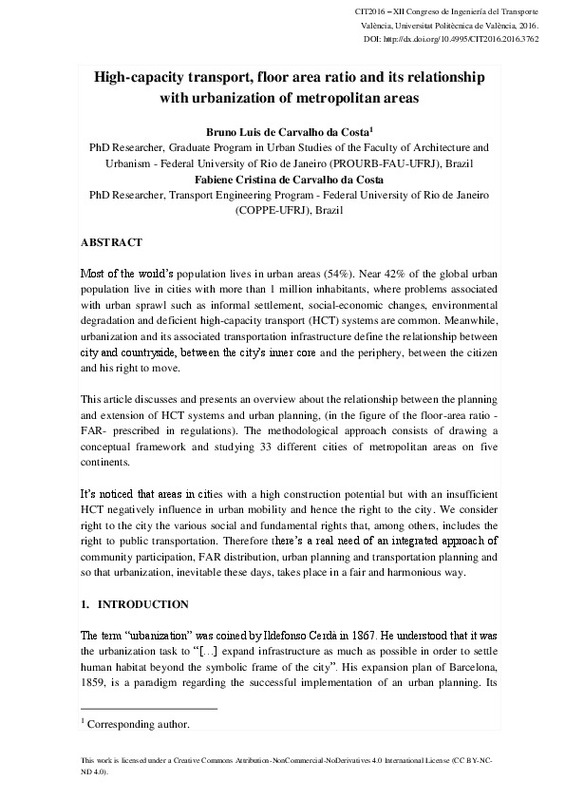JavaScript is disabled for your browser. Some features of this site may not work without it.
Buscar en RiuNet
Listar
Mi cuenta
Estadísticas
Ayuda RiuNet
Admin. UPV
High-capacity transport, floor area ratio and its relationship with urbanization of metropolitan areas
Mostrar el registro sencillo del ítem
Ficheros en el ítem
| dc.contributor.author | de Carvalho da Costa, Bruno
|
es_ES |
| dc.contributor.author | de Carvalho da Costa, Fabiene
|
es_ES |
| dc.date.accessioned | 2017-11-03T09:35:54Z | |
| dc.date.available | 2017-11-03T09:35:54Z | |
| dc.date.issued | 2016-06-01 | |
| dc.identifier.isbn | 9788460899600 | |
| dc.identifier.uri | http://hdl.handle.net/10251/90370 | |
| dc.description.abstract | [EN] Most of the world’s population lives in urban areas (54%). Near 42% of the global urban population live in cities with more than 1 million inhabitants, where problems associated with urban sprawl such as informal settlement, social-economic changes, environmental degradation and deficient high-capacity transport (HCT) systems are common. Meanwhile, urbanization and its associated transportation infrastructure define the relationship between city and countryside, between the city’s inner core and the periphery, between the citizen and his right to move. This article discusses and presents an overview about the relationship between the planning and extension of HCT systems and urban planning, (in the figure of the floor-area ratio - FAR- prescribed in regulations). The methodological approach consists of drawing a conceptual framework and studying 33 different cities of metropolitan areas on five continents. It’s noticed that areas in cities with a high construction potential but with an insufficient HCT negatively influence in urban mobility and hence the right to the city. We consider right to the city the various social and fundamental rights that, among others, includes the right to public transportation. Therefore there’s a real need of an integrated approach of community participation, FAR distribution, urban planning and transportation planning and so that urbanization, inevitable these days, takes place in a fair and harmonious way. | es_ES |
| dc.format.extent | 12 | es_ES |
| dc.language | Inglés | es_ES |
| dc.publisher | Editorial Universitat Politècnica de València | es_ES |
| dc.relation.ispartof | XII Congreso de ingeniería del transporte. 7, 8 y 9 de Junio, Valencia (España) | es_ES |
| dc.rights | Reconocimiento - No comercial - Sin obra derivada (by-nc-nd) | es_ES |
| dc.subject | Transport Planning | es_ES |
| dc.subject | Urban Planning | es_ES |
| dc.subject | Floor Area Ratio | es_ES |
| dc.subject | Density | es_ES |
| dc.title | High-capacity transport, floor area ratio and its relationship with urbanization of metropolitan areas | es_ES |
| dc.type | Capítulo de libro | es_ES |
| dc.type | Comunicación en congreso | es_ES |
| dc.identifier.doi | 10.4995/CIT2016.2015.3762 | |
| dc.rights.accessRights | Abierto | es_ES |
| dc.description.bibliographicCitation | De Carvalho Da Costa, B.; De Carvalho Da Costa, F. (2016). High-capacity transport, floor area ratio and its relationship with urbanization of metropolitan areas. En XII Congreso de ingeniería del transporte. 7, 8 y 9 de Junio, Valencia (España). Editorial Universitat Politècnica de València. 646-657. https://doi.org/10.4995/CIT2016.2015.3762 | es_ES |
| dc.description.accrualMethod | OCS | es_ES |
| dc.relation.conferencename | CIT2016. Congreso de Ingeniería del Transporte | es_ES |
| dc.relation.conferencedate | June 07-09,2016 | es_ES |
| dc.relation.conferenceplace | Valencia, Spain | es_ES |
| dc.relation.publisherversion | http://ocs.editorial.upv.es/index.php/CIT/CIT2016/paper/view/3762 | es_ES |
| dc.description.upvformatpinicio | 646 | es_ES |
| dc.description.upvformatpfin | 657 | es_ES |
| dc.type.version | info:eu-repo/semantics/publishedVersion | es_ES |
| dc.relation.pasarela | OCS\3762 | es_ES |








